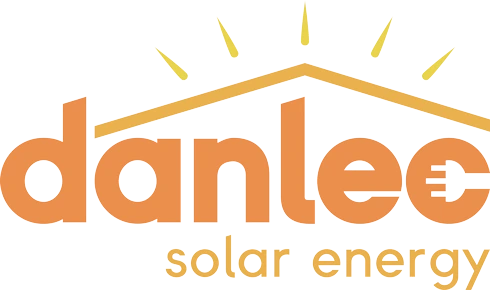How Do Solar Panels Work On A House?

Solar panels are an excellent solution to reducing energy costs and helping protect the environment. Solar panels can power your home with clean, renewable energy.
But how exactly do solar panels work to power your home? Solar panels work by converting sunlight into electricity using photovoltaic (PV) cells. Photovoltaic cells are made of semiconductor material, such as silicon, that absorbs the photons of light from the sun and converts them into electrical energy.
The direct current (DC) electricity produced by the photovoltaic cells is then converted to alternating current (AC) electricity using an inverter, which makes it suitable for use in homes and businesses. The AC electricity is then sent to the electrical panel where it is distributed to power lights, appliances, and other devices.
This process of converting sunlight into usable electricity helps reduce dependence on fossil fuels, lower greenhouse gas emissions, and improve energy independence.
Contact us today to find out more
How Do Solar Panels Work To Generate Electricity?
Solar panels work by converting light energy from the sun into electrical energy. Photovoltaic (PV) cells, made of semiconductor materials, absorb sunlight and knock electrons loose from their atoms, creating a flow of electricity. This direct current (DC) electricity can then be converted into alternating current (AC) electricity, which is what is typically used in homes and businesses.
The Three Different Types Of Solar Panels:
The three main types of solar panels are:
- Monocrystalline
- Polycrystalline
- Thin-film solar panels (amorphous silicon, CdTe, CIGS)
Monocrystalline solar panels are made from a single crystal structure of silicon, making them the most efficient type of solar panel. They have a uniform, dark black appearance and tend to be more expensive than other types of solar panels.
However, their high efficiency can lead to a higher return on investment over time. Monocrystalline solar panels are ideal for areas with limited space, such as residential rooftops, where maximising energy production is a priority.
Polycrystalline solar panels are made from multiple crystal structures of silicon, making them less efficient than monocrystalline panels. They have a speckled blue appearance and tend to be less expensive than monocrystalline panels.
Despite their lower efficiency, polycrystalline panels are still a popular choice for many residential and commercial solar installations because of their lower cost and good performance. They are also more resistant to temperature changes than monocrystalline panels and may perform better in very hot climates.
Thin-film solar panels are a type of solar panel made from a thin layer of photovoltaic material, typically amorphous silicon, cadmium telluride (CdTe), or copper indium gallium selenide (CIGS). They are the least efficient type of solar panel, but they have several advantages over other types of panels.
Thin-film panels are lighter, more flexible, and less sensitive to shading than other types of solar panels. They are also typically more affordable, making them a good choice for large-scale solar installations or for use in developing countries where cost is a major factor. Additionally, thin-film panels can be manufactured in a variety of sizes and shapes, allowing for greater design flexibility.

Benefits Of Having Solar Panels
Solar panels are useful because they provide a clean and renewable source of electricity.
They are useful for:
☑️Reducing reliance on fossil fuels and reducing greenhouse gas emissions
☑️Decreasing electricity costs for homes and businesses
☑️Providing a source of electricity in remote or off-grid locations
☑️Increasing energy security by reducing dependence on imported energy
☑️Supporting sustainable development and combating climate change

Solar panels can also be combined with energy storage systems, such as batteries, to provide electricity even when the sun is not shining. This makes them a versatile and cost-effective solution for a wide range of energy needs.
How to choose the right solar panel system for your home
To choose the right solar panel system for your home, consider the following factors:
- Energy consumption: Analyse your energy consumption patterns to determine the size of the solar panel system you need.
- Roof orientation and shading: Check the orientation and shading of your roof to determine the optimal location for the solar panel system.
- Climate: Consider the climate in your area, as different climates may affect the performance of the solar panels.
- Budget: Determine your budget and look for solar panel systems that fit within it.

- System components: Consider the quality and warranty of the solar panels, inverter, and other components of the system.
- Installation and maintenance: Look for a reputable installation company and ensure that the system comes with a comprehensive maintenance plan.
- Government incentives: Check for government incentives, such as tax credits or rebates, that can help offset the cost of the system.
- Future plans: Consider any future plans for your home, such as additions or renovations, to ensure that the solar panel system will still meet your needs.
It may be helpful to consult with a solar energy professional or get multiple quotes from different companies to compare and choose the best option for your needs and budget.
At Danlec, we provide homes and businesses with Energy Saving Electrical, EV Charging and Solar Energy Systems.
By choosing us you can be sure that your solar installation is completed quickly, safely and professionally. Plus, you’ll have peace of mind knowing that you’re helping reduce your carbon footprint by utilising renewable energy sources. Let us help you make the switch to solar energy today.
Choose your PV system here
Solar Panel FAQs
Q: What are photovoltaic (PV) cells?
A: Photovoltaic cells are made of semiconductor materials that absorb photons from the sun and release electrons, which are collected by metal contacts to generate DC electricity.
Q: How does the DC electricity get converted into a usable form?
A: The DC electricity is converted into alternating current (AC) electricity by an inverter, making it usable for homes and businesses.
Q: Can solar panels work on cloudy days?
A: Yes, solar panels can still produce some electricity on cloudy days, although the output will be lower than on sunny days.
Q: What happens to the electricity generated by solar panels when not in use?
A: The electricity generated by solar panels can be used immediately, stored in batteries, or fed back into the grid.
Q: How long do solar panels last?A: Solar panels typically have a lifespan of 25-30 years and can continue to produce electricity after that, although at a reduced output.









